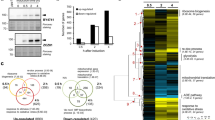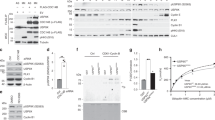Abstract
The p21-activated kinases (PAKs) are effectors for the Rho-family GTPase Cdc42p. Here we define the in vivo function of the kinase activity of the budding yeast PAK Cla4p, using cla4 alleles that are specifically inhibited by a cell-permeable compound that does not inhibit the wild-type kinase. CLA4 kinase inhibition in cells lacking the partially redundant PAK Ste20p causes reversible SWE1-dependent cell-cycle arrest and gives rise to narrow, highly elongated buds in which both actin and septin are tightly polarized to bud tips. Inhibition of Cla4p does not prevent polarization of F-actin, and cytokinesis is blocked only in cells that have not formed a bud before inhibitor treatment; cell polarization and bud emergence are not affected by Cla4p inhibition. Although localization of septin to bud necks is restored in swe1Δ cells, cytokinesis remains defective. Inhibition of Cla4p activity in swe1Δ cells causes a delay of bud emergence after cell polarization, indicating that this checkpoint may mediate an adaptive response that is capable of promoting budding when Cla4p function is reduced. Our data indicate that CLA4 PAK activity is required at an early stage of budding, after actin polarization and coincident with formation of the septin ring, for early bud morphogenesis and assembly of a cytokinesis site.
This is a preview of subscription content, access via your institution
Access options
Subscribe to this journal
Receive 12 print issues and online access
$209.00 per year
only $17.42 per issue
Buy this article
- Purchase on Springer Link
- Instant access to full article PDF
Prices may be subject to local taxes which are calculated during checkout






Similar content being viewed by others
References
Hall, A. Rho GTPases and the actin cytoskeleton. Science 279, 509–514 (1998).
Bagrodia, S. & Cerione, R. A. Pak to the future. Trends Cell Biol. 9, 350–355 (1999).
Adams, A. E., Johnson, D. I., Longnecker, R. M., Sloat, B. F. & Pringle, J. R. CDC42 and CDC43, two additional genes involved in budding and the establishment of cell polarity in the yeast Saccharomyces cerevisiae. J. Cell Biol. 111, 131–142 (1990).
Kozminski, K. G., Chen, A. J., Rodal, A. A. & Drubin, D. G. Functions and functional domains of the GTPase Cdc42p. Mol. Biol. Cell 11, 339–354 (2000).
Field, C. M. & Kellogg, D. Septins: cytoskeletal polymers or signalling GTPases? Trends Cell Biol. 9, 387–394 (1999).
Longtine, M. S. et al. The septins: roles in cytokinesis and other processes. Curr. Opin. Cell Biol. 8, 106–119 (1996).
Longtine, M. S., Fares, H. & Pringle, J. R. Role of the yeast Gin4p protein kinase in septin assembly and the relationship between septin assembly and septin function. J. Cell Biol. 143, 719–736 (1998).
Frazier, J. A. et al. Polymerization of purified yeast septins: evidence that organized filament arrays may not be required for septin function. J. Cell Biol. 143, 737–749 (1998).
Peter, M., Neiman, A. M., Park, H. O., van Lohuizen, M. & Herskowitz, I. Functional analysis of the interaction between the small GTP binding protein Cdc42 and the Ste20 protein kinase in yeast. EMBO J. 15, 7046–7059 (1996).
Cvrckova, F., De Virgilio, C., Manser, E., Pringle, J. R. & Nasmyth, K. Ste20-like protein kinases are required for normal localization of cell growth and for cytokinesis in budding yeast. Genes Dev. 9, 1817–1830 (1995).
Benton, B. K., Tinkelenberg, A., Gonzalez, I. & Cross, F. R. Cla4p, a Saccharomyces cerevisiae Cdc42p-activated kinase involved in cytokinesis, is activated at mitosis. Mol. Cell Biol. 17, 5067–5076 (1997).
Leberer, E., Dignard, D., Harcus, D., Thomas, D. Y. & Whiteway, M. The protein kinase homologue Ste20p is required to link the yeast pheromone response G-protein beta gamma subunits to downstream signalling components. EMBO J. 11, 4815–4824 (1992).
Martin, H., Mendoza, A., Rodriguez-Pachon, J. M., Molina, M. & Nombela, C. Characterization of SKM1, a Saccharomyces cerevisiae gene encoding a novel Ste20/PAK-like protein kinase. Mol. Microbiol. 23, 431–444 (1997).
Eby, J. J. et al. Actin cytoskeleton organization regulated by the PAK family of protein kinases. Curr. Biol. 8, 967–970 (1998).
Holly, S. P. & Blumer, K. J. PAK-family kinases regulate cell and actin polarization throughout the cell cycle of Saccharomyces cerevisiae. J. Cell Biol. 147, 845–856 (1999).
Delley, P. A. & Hall, M. N. Cell wall stress depolarizes cell growth via hyperactivation of RHO1. J. Cell Biol. 147, 163–174 (1999).
Brown, J. L., Jaquenoud, M., Gulli, M. P., Chant, J. & Peter, M. Novel Cdc42-binding proteins Gic1 and Gic2 control cell polarity in yeast. Genes Dev. 11, 2972–2982 (1997).
Chen, G. C., Kim, Y. J. & Chan, C. S. The Cdc42 GTPase-associated proteins Gic1 and Gic2 are required for polarized cell growth in Saccharomyces cerevisiae. Genes Dev. 11, 2958–2971 (1997).
Bi, E. et al. Identification of novel, evolutionarily conserved Cdc42p-interacting proteins and of redundant pathways linking Cdc24p and Cdc42p to actin polarization in yeast. Mol. Biol. Cell 11, 773–793 (2000).
Bishop, A. C. et al. Design of allele-specific inhibitors to probe protein kinase signaling. Curr. Biol. 8, 257–266 (1998).
Liu, Y., Shah, K., Yang, F., Witucki, L. & Shokat, K. M. Engineering Src family protein kinases with unnatural nucleotide specificity. Chem. Biol. 5, 91–101 (1998).
Liu, Y. et al. Structural basis for selective inhibition of Src family kinases by PP1. Chem. Biol. 6, 671–678 (1999).
Schindler, T. et al. Crystal structure of Hck in complex with a Src family-selective tyrosine kinase inhibitor. Mol. Cell 3, 639–648 (1999).
Tjandra, H., Compton, J. & Kellogg, D. Control of mitotic events by the Cdc42 GTPase, the Clb2 cyclin and a member of the PAK kinase family. Curr. Biol. 8, 991–1000 (1998).
Ayscough, K. R. et al. High rates of actin filament turnover in budding yeast and roles for actin in establishment and maintenance of cell polarity revealed using the actin inhibitor latrunculin-A. J. Cell Biol. 137, 399–416 (1997).
Johnston, L. H. & Johnson, A. L. Elutriation of budding yeast. Methods Enzymol. 283, 342–350 (1997).
Dohmen, R. J., Wu, P. & Varshavsky, A. Heat-inducible degron: a method for constructing temperature-sensitive mutants. Science 263, 1273–1276 (1994).
Lew, D. J. & Reed, S. I. A cell cycle checkpoint monitors cell morphogenesis in budding yeast. J. Cell Biol. 129, 739–749 (1995).
McMillan, J. N. et al. The morphogenesis checkpoint in Saccharomyces cerevisiae: cell cycle control of Swe1p degradation by Hsl1p and Hsl7p. Mol. Cell Biol. 19, 6929–6939 (1999).
Shulewitz, M. J., Inouye, C. J. & Thorner, J. Hsl7 localizes to a septin ring and serves as an adapter in a regulatory pathway that relieves tyrosine phosphorylation of Cdc28 protein kinase in Saccharomyces cerevisiae. Mol. Cell Biol. 19, 7123–7137 (1999).
Lew, D. J. Cell-cycle checkpoints that ensure coordination between nuclear and cytoplasmic events in Saccharomyces cerevisiae. Curr. Opin. Genet. Dev. 10, 47–53 (2000).
Elledge, S. J. Cell cycle checkpoints: preventing an identity crisis. Science 274, 1664–1672 (1996).
Wu, C., Lytvyn, V., Thomas, D. Y. & Leberer, E. The phosphorylation site for Ste20p-like protein kinases is essential for the function of myosin-I in yeast. J. Biol. Chem. 272, 30623–30626 (1997).
Lechler, T., Shevchenko, A. & Li, R. Direct involvement of yeast type I myosins in Cdc42-dependent actin polymerization. J. Cell Biol. 148, 363–373 (2000).
Chenevert, J., Corrado, K., Bender, A., Pringle, J. & Herskowitz, I. A yeast gene (BEM1) necessary for cell polarization whose product contains two SH3 domains. Nature 356, 77–79 (1992).
Drubin, D. G., Mulholland, J., Zhu, Z. M. & Botstein, D. Homology of a yeast actin-binding protein to signal transduction proteins and myosin-I. Nature 343, 288–290 (1990).
Guthrie, C. & Fink, G. R. (eds) Guide to Yeast Genetics and Molecular Biology (Academic, San Diego, 1991).
Towbin, H., Staehelin, T. & Gordon, J. Electrophoretic transfer of proteins from polyacrylamide gels to nitrocellulose sheets: procedure and some applications. Proc. Natl Acad. Sci. USA 76, 4350–4354 (1979).
Anderson, C. W., Baum, P. R. & Gesteland, R. F. Processing of adenovirus 2-induced proteins. J. Virol. 12, 241–252 (1973).
Cope, M. J., Yang, S., Shang, C. & Drubin, D. G. Novel protein kinases Ark1p and Prk1p associate with and regulate the cortical actin cytoskeleton in budding yeast. J. Cell Biol. 144, 1203–1218 (1999).
Mulholland, J. et al. Ultrastructure of the yeast actin cytoskeleton and its association with the plasma membrane. J. Cell Biol. 125, 381–391 (1994).
Acknowledgements
We thank H. Tjandra, D. Kellogg, M. Longtine, M. Shulewitz, J. Thorner, F. Cvrcova, S. Holly and K. Blumer for providing essential strains, plasmids, and antibodies, and S. Biggins and J. Li for assistance with elutriation. We also thank J. Ubersax and members of the Drubin and Barnes laboratories, particularly M. J. T. V. Cope, M. Duncan, K. Kozminski and D. Seikhaus, for helpful discussions. E.L.W. is supported by an American Cancer Society postdoctoral fellowship; support for this work was also provided by a grant from the National Institutes of Health (to D.G.D.).
Author information
Authors and Affiliations
Corresponding author
Additional information
Correspondence and requests for materials should be addressed to D.G.D.
Rights and permissions
About this article
Cite this article
Weiss, E., Bishop, A., Shokat, K. et al. Chemical genetic analysis of the budding-yeast p21-activated kinase Cla4p. Nat Cell Biol 2, 677–685 (2000). https://doi.org/10.1038/35036300
Received:
Revised:
Accepted:
Published:
Issue Date:
DOI: https://doi.org/10.1038/35036300
This article is cited by
-
The final cut: cell polarity meets cytokinesis at the bud neck in S. cerevisiae
Cellular and Molecular Life Sciences (2016)
-
A conserved water-mediated hydrogen bond network defines bosutinib's kinase selectivity
Nature Chemical Biology (2014)
-
The septin family of GTPases: architecture and dynamics
Nature Reviews Molecular Cell Biology (2008)
-
The kinase-inhibitory domain of p21-activated kinase 1 (PAK1) inhibits cell cycle progression independent of PAK1 kinase activity
Oncogene (2007)
-
A second-site suppressor strategy for chemical genetic analysis of diverse protein kinases
Nature Methods (2005)



